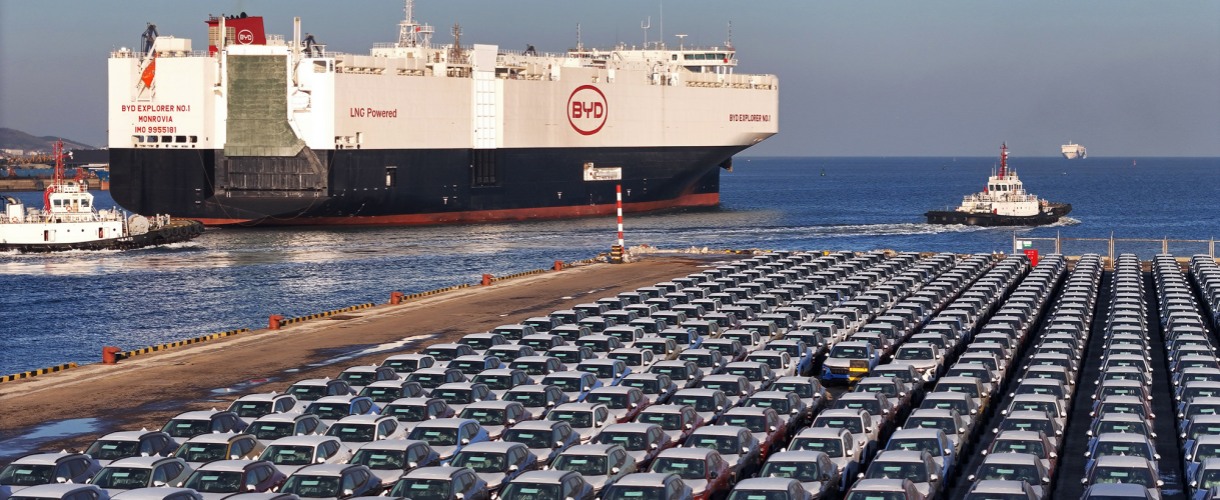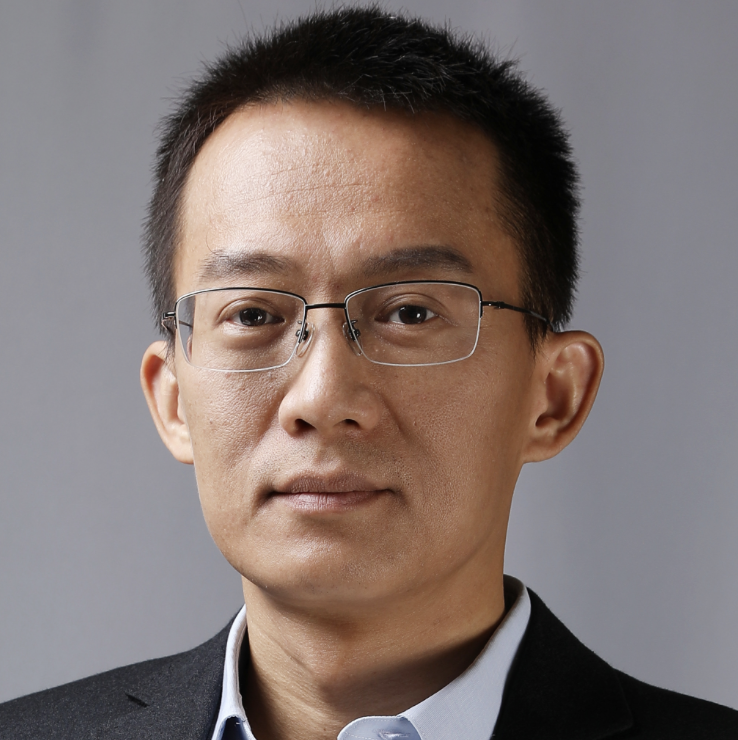What Did the Chinese Government Do Right with Electric Vehicles?

Introduction:
In recent years, the U.S. and the European Union have ramped up their accusations against China’s vehicle industry for alleged unfair competition due to government subsidies and industrial policies. Little do they know of the on-the-ground situation where it is not the beneficiaries of government support who are leading the Chinese EV car industry, and that a significant portion of the subsidy never served its purpose, ending up in scandalous frauds.
So, what role has Chinese industrial policy played in the development of new energy vehicles? Is it a well-funded gambler or a far-sighted strategist?
“Wenhua Zongheng” , a quarterly journal on Chinese thoughts discussed the issue with leading public policy researchers Feng Kaidong and Lei Shaohua.
 The maiden voyage ceremony for BYD Explorer No.1, the 7,000 CEU LNG dual-fuel pure car, truck carrier (PCTC), was held on January 15 at the Port of Shenzhen.
The maiden voyage ceremony for BYD Explorer No.1, the 7,000 CEU LNG dual-fuel pure car, truck carrier (PCTC), was held on January 15 at the Port of Shenzhen.
WenHua ZongHeng :
First, let’s talk about the reasons behind the rise of China’s new energy vehicles (NEVs). When discussing this issue, many people often mention the role played by the government. In recent years, the United States and the European Union have started investigating and implementing protectionist measures such as increased tariffs or other restrictions on Chinese exports of new energy vehicles, citing China’s industrial policies as distorting fair competition.
However, from a domestic perspective, we also see that the best performers in the transition to new energy vehicles are not the state-owned enterprises most closely linked to the government, but rather private companies like BYD, Geely, and Li Auto. These private companies were not the primary focus of government support. So, how should we view and assess the role of the Chinese government in the rise of China’s new energy vehicle industry?
Feng Kaidong:
When discussing the role of the government in an industry, we must first clarify which dimension of government involvement we are talking about.
If we refer to the government directly selecting specific technologies or enterprises—a traditional command economy model where the government supports certain businesses and industries—then China’s government has not been particularly successful.
Since the “863 Program”【1】 first proposed the “Three Vertical and Three Horizontal” 【2】strategic plan for electric vehicles in 2021, and after 15 years of continuous investment until the inclusion of new energy vehicles in the National Key Research and Development Program of China during the “13th Five-Year Plan,” 【3】the Chinese government has made some mistakes in both technical routes and the selection of demonstration enterprises.
The targets supported by the Chinese government, whether those early supported by the “863 Program” or those chosen by local governments during the implementation of the “Ten Cities, Thousand Vehicles”【4】 initiative, are actually not the most active companies in the current development of new energy vehicles in China, nor are they the most active technologies. For example, the range-extender technology that emerged later was mainly developed spontaneously by the market. The government had not anticipated this technology, let alone provided preliminary research and support for it.
However, from an evolutionary perspective, I believe the Chinese government has played a significant role in the rise of NEVs. The missteps we have taken were highly meaningful.
Firstly, a widely agreed-upon point among economists is that it has been crucial for talent development, planting seeds of talent and teams within universities and enterprises.
For instance, nearly 15,000 engineering and technical personnel participated in projects during the first two five-year plans (2001-2010). Though some technologies they worked on, like Chery’s collaboration with Ricardo of the UK on hybrid technology, did not become mainstream in the domestic NEV market, the talents cultivated during the “863 Program” have played vital roles in the subsequent development of China’s NEV industry. Leaders like Liu Xinwen of YUDO and Fang Yunzou of Neta grew up within these projects.
Moreover, the industry gradually clarified the direction of technological development.
The focuses of the initial “Three Verticals and Three Horizontals” differ completely from those after 2015. These adjustments became clearer after early government-supported R&D projects, highlighting the prospects and potential of technological development. This trial-and-error process is unavoidable.
I believe the second stage of government support began with the “Ten Cities, Thousand Vehicles” program in 2009.
The goal of this plan was to have 500,000 new energy vehicles on the road by the end of 2015.
This is the classic model of implementing public policy in China: by selecting pilot city clusters and allowing each locality to do its best to promote the development of the new energy vehicle industry. From a purely numerical perspective, this phase may not seem very successful.
By the mid-term evaluation in 2013, it was clear that they were far from reaching this target. Later, in December 2014, a last-minute push sold 70,000 to 80,000 vehicles, barely reaching a total of just over 490,000 vehicles, preventing the policy from being a complete failure.
However, this stage was also very significant. Looking back at today’s Chinese new energy vehicle industry, many important supporting and component companies have grown under the strong policy support of local governments. Creating a new industry and an industrial chain has significant entry barriers. Without the support of local governments to create development expectations, it would have been relatively difficult for private sectors to overcome these barriers solely through their investments. It was precisely due to the protection provided by local governments at the right time that the foundation for today’s Chinese new energy vehicle component system was laid.

Therefore, from a long-term perspective rather than a short-term one, the role of government policy support is substantial. Moreover, this support has not been limited to state-owned enterprises; it has also extended to private and foreign enterprises. A notable example is Tesla, which received a series of supports from the Shanghai local government and domestic infrastructure investments. Hence, the general support measures by the government for the entire industry have played a significant role in the development of China’s new energy vehicles.
Additionally, I want to emphasize that the criticisms and accusations from Western countries are unreasonable. When China’s new energy vehicles began to be exported on a large scale, it was after 2023, and domestic purchase subsidies had already been completely phased out by the end of 2022. Therefore, criticizing China’s new energy vehicles under the pretext of government subsidies and support is unjustified from a trade policy perspective.
Lei Shaohua:
A few years ago, Justin Yifu Lin【4】 and Professor Zhang Weiying【5】 had a major debate about industrial policy.
The main criticism of industrial policy is that it allows the “visible foot” of the government to step on the “invisible hand” of the market. Neoliberal economics emphasizes free market competition rather than government intervention; industrial policy represents a classic case of direct government intervention in the market.
When we revisit Justin Yifu Lin ‘s views, he emphasizes two key concepts: the first is an “active government,” and the second is an “effective market.” In other words, Professor Lin defines industrial policy not as a planned economy or direct support for certain enterprises with unequal market treatment or direct subsidies, but as the government’s role in creating a favorable legal, economic, and social environment for the entire industry’s development.
Industrial policy is not about the government directly intervening in the market or enterprises but rather about the government nurturing and fostering the market.
I would like to add a third factor to industrial policy: “strong consensus.” I believe that only with the addition of “strong consensus” to “active government” and “effective market” can industrial policy truly become an important method for developing countries to catch up with advanced nations.
When discussing the role of industrial policy, many people often focus on its impact on the market, enterprises, and technological development. However, I believe the more important aspect is that industrial policy shapes a strong consensus.
In China’s unique political environment, the significance of industrial policy lies in its construction of three consensuses: the first is the consensus between the central and local governments, the second is the consensus between capital and the market, and the third is the consensus among consumers.
We know that China already has a large, traditional automobile manufacturing system and market, which includes various types of enterprises—central state-owned enterprises, local state-owned enterprises, and private enterprises.
Additionally, our tax system creates a natural inclination for local governments to protect their traditional sources of local revenue because they need to safeguard their “pockets.” Therefore, mobilizing the enthusiasm of local governments and making them realize that new industries can expand rather than disrupt their traditional tax revenues is a crucial and challenging issue, given the differences in interests between the central and local governments. In this context, achieving consensus between central and local governments is a critical role of industrial policy.
The second is the consensus between capital and the market.For traditional fuel vehicles, whether domestic or joint ventures, the capital investment is clear and predictable. However, developing a new industry like new energy vehicles involves unpredictable market trends and requires substantial capital investment beyond the scope of traditional capital markets, posing significant risks. Achieving consensus between capital and the market is also where industrial policy needs to exert its influence.
The third is forming consumer consensus on new products. In other words, government industrial policy endorsements give ordinary Chinese citizens the confidence to purchase new energy vehicles.
 Visitors take photos of a Zeekr car during the opening of China Auto Show in Beijing, China, April 25, 2024. (AP Photo)
Visitors take photos of a Zeekr car during the opening of China Auto Show in Beijing, China, April 25, 2024. (AP Photo)
Only by achieving these three consensuses can we create an environment where capital is willing to invest in new technologies, consumers are willing to buy into less mature technologies, and local governments can tolerate the risk of their traditional revenue sources being impacted.
The Chinese government does not subsidize specific enterprises but provides indiscriminate subsidies to the entire industry during the gestation period of new industries. Consequently, this process inevitably leads to considerable confusion, such as the issue of subsidy fraud. Subsidy fraud is a major criticism from some media and neoliberal economists regarding the development of China’s new energy vehicle industry, viewing it as a significant waste.
However, a local government leader once remarked, which left a deep impression on me, “Do we not know that there is subsidy fraud? We are well aware, but why do we still insist on indiscriminate subsidies? Because we don’t know which technological route will stand out in the fierce market competition. We can’t negate the entire industrial policy just because of a few cases of subsidy fraud, just as we can’t throw out the baby with the bathwater.”
Therefore, the costs incurred during the development process are also part of industrial policy. Not all industrial policies are successful; many fail. However, our industrial policy is not a short-term measure but a long-term process involving continuous adjustments. It helps build confidence in society to collectively invest in and develop new industries and markets.
I believe that industrial policy is becoming a crucial aspect of major power competition, and only major powers can formulate such policies. More importantly, the criticism from some Western countries about China’s industrial policy stems from their fear of China’s emergence in many new industrial fields driven by these policies. Additionally, it forces them to formulate their own industrial policies.
We have recently seen the United States enact many industrial policies, such as the “CHIPS and Science Act” and various protective measures in different fields. This increasingly undermines the set of economic theories they have long based on neoliberal economics.
Clearly, the new developments in industries like new energy vehicles may trigger conflicts and changes in political systems and modern governance. The impact of this prospect is profound. Therefore, the discussion on industrial policy is not just a traditional economic issue but also a political one.
Original link:https://mp.weixin.qq.com/s/par5SyEs5gOdiIpqIhTMIg
Editor: Zhongxiaowen
【1】863 Program:The "863 Program" is China's high-tech development plan, named after its establishment in March 1986. Its goal is to select strategic technologies and concentrate support for related enterprises, research institutes, or universities.
In 2001, the Ministry of Science and Technology (MOST) issued a strategic plan for new energy vehicles and conducted research through a special project on electric vehicles. In September of the same year, as part of the "863 Program" during the Tenth Five-Year Plan period, MOST specifically established a major project on electric vehicles.
【2】Three Verticals and Three Horizontals:In 2004, the Ministry of Science and Technology summarized its statistical analysis of the major projects under the "863 Program". By that year, the Electric Vehicle Special Project had established a comprehensive research and development framework known as the "Three Verticals and Three Horizontals". The "Three Verticals" included fuel cell vehicles, hybrid electric vehicles, and pure electric vehicles, while the "Three Horizontals" encompassed multi-energy powertrain control, electric drive motors, and power storage batteries.
【3】The Five-Year plans:The "Five-Year Plan" is an important part of China's national economic planning and constitutes a long-term strategy. It primarily involves planning major national construction projects, the distribution of productive forces, and significant proportions of the national economy, setting goals and directions for the long-term development of the national economy.
China began formulating its first "Five-Year Plan" in 1953. On March 11, 2021, the Fourth Session of the Thirteenth National People's Congress voted to approve the Fourteenth Five-Year Plan for National Economic and Social Development, which outlines China's economic and social development goals for the period.
【4】Ten Cities, Thousand Vehicles:The "Ten Cities, Thousand Vehicles" project, officially known as the "Demonstration and Promotion Project of Energy-saving and New Energy Vehicles with One Thousand Vehicles in Ten Cities," primarily aims to promote the use of energy-saving and new energy vehicles in China. Starting from 2009, the project plans to achieve this over approximately three years by annually developing ten cities, each introducing 1000 new energy vehicles for demonstration and operation. This initiative encompasses various sectors such as public transportation, taxis, government vehicles, municipal vehicles, and postal services in these large and medium-sized cities. The goal is to strive for new energy vehicles to constitute 10% of the national automotive market share by 2012, supported through fiscal subsidies provided by the government.
【5】Justin Yifu Lin :Chinese economist and professor of economics at Peking University.He served as the Chief Economist and Senior Vice President of the World Bank from 2008 to 2012.
His main academic theory is called New Structural Economics.
NSE maintains that developing countries or regions should develop industries that conform to their comparative advantages based on their factor endowments structure. It seeks synergies between an effective market and a facilitating government in an effort to achieve economic transformation and upgrading as well as economic and social development.
【6】Zhang Weiying:Chinese economist and was head of the Guanghua School of Management, Peking University. He is known for his advocacy of free markets and his ideas have been influenced by the Austrian School.





